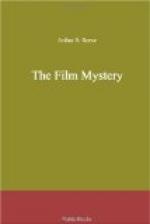“When the film in the camera is developed—” I suggested to Kennedy, suddenly.
He silenced me with a gesture. “I haven’t overlooked that, but the scenes will be from one angle only and in a darkened set. I can determine more this way.”
Somewhat crestfallen, I continued my impersonation of the slain star not altogether willingly. Soon Kennedy had completed his reconstruction of the action.
“Who else entered the scene besides Gordon?” he asked.
“The butler and the maid, after the lights were flashed on.”
“I’ll question the camera men,” he announced. “Who are they?”
“Harry Watkins is the head photographer,” Werner explained. “He’s a crackerjack, too! One of the best lighting experts in the country. Al Penny’s grinding the other box.”
“Let’s have Watkins first.” Kennedy nodded to Mackay to escort the director from the room.
Neither Watkins nor Penny were able to add anything to the facts which Kennedy had gleaned from Manton and Werner. When he had finished his patient examination of the junior camera man he recalled Watkins and had both, under his eyes, close and seal the film cartridges which contained the photographic record of the thirteen scenes. Dismissing the men, he handed the two black boxes to Mackay.
“Can you arrange to have these developed and printed, quickly, but in some way so neither negative nor positive will be out of your sight at any time?”
Mackay nodded. “I know the owner of a laboratory in Yonkers.”
“Good! Now let’s have the leading man.”
Jack Gordon immediately impressed me very unfavorably. There was something about him for which I could find no word but “sleek.” Learning much from my long association with Kennedy I observed at once that he had removed the make-up from his face and that he had on a clean white collar. Since the linen worn before the camera is dyed a faint tint to prevent the halation caused by pure white, it was a sure sign to me that he had spruced up a bit. I knew that he was engaged to Stella. Here in this room she lay dead, under the most mysterious circumstances. There was little question, in fact, that she had been murdered. How could he, really loving her, think of such things as the make-up left on his face, or his clothes?
I had to admit that he was a handsome individual. Perhaps slightly less than average in height, and very slender, he had the close-knit build of an athlete. The contour of his head and the perfect regularity of rather large features made him an ideal type for the screen at any angle; in close-ups and foregrounds as well as full shots. In actual life there were little things covered by make-up in his work, such as the cold gray tint of his eyes and the lines of dissipation about his mouth.
Kennedy questioned him first about his movements in the different scenes, then asked him if he had seen or noticed anything suspicious during the taking of any of them or in the intervals between.




